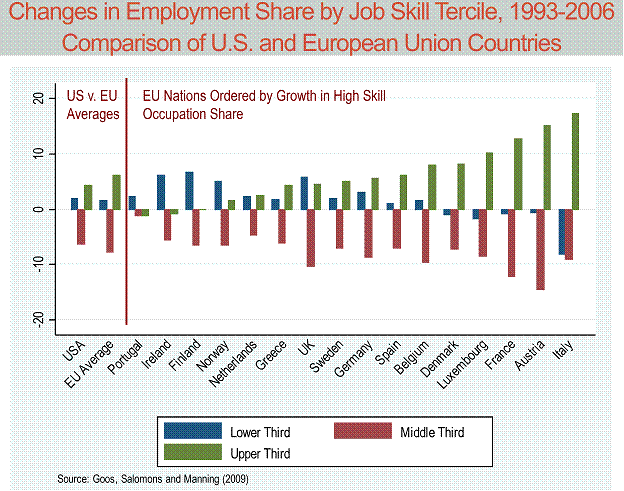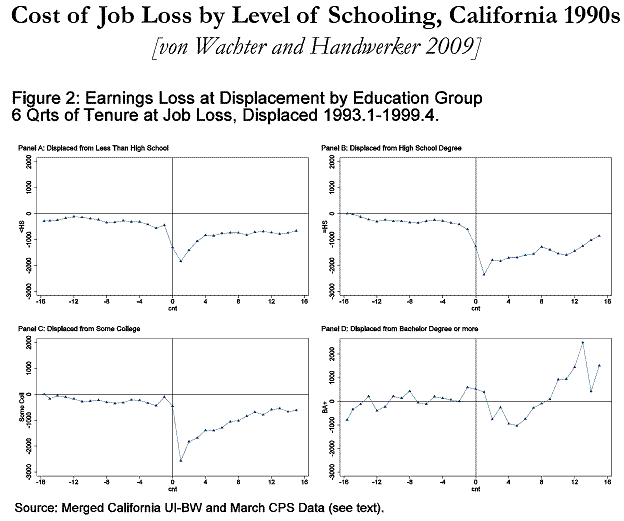I spent the better part of last Friday at an Institute for Research on Poverty conference, entitled “Employment Prospects for Lower Wage Workers: Easing the Implications of a Slow Recovery Conference”. It was a tremendous learning experience for me (since I’m not a labor economist), and a chance to be reminded of the full enormity of the challenges facing policymakers, as the economy limps in a fitful recovery, with little succor from further aggregate demand stimulus measures, and threatened by supply shocks as well as incoherence in fiscal policymaking. I mentioned the conference in a post last week, but the presentations and papers are now online.
The first presentation, entitled “The ‘Polarization’ of U.S.Employment Demand”, was by David Autor (MIT), who outlined the following:
1. Two inertial forces on a collision course
a. Polarization of job opportunities, reducing opportunities for middle-educated workers (high school grad esp)
b. Stagnating educational attainment
2. Males are adapting particularly poorly
3. Social consequences extend beyond labor market
4. Why job opportunities are polarizing
Technological change (of course)
- Trade also appears an important factor
5. Policy responses
- Boosting college attainment (of course)
- Enabling non-college workers to enter good careers
Professor Autor highlighted many points; one was the decline in share of middle-skill jobs, contrary to the oft asserted loss of low-skilled jobs. This conclusion was illustrated in this slide:

Figure from Autor.
Perhaps the most interesting at least to me included those pertaining to the impact of China. Autor and co-authors, as recounted in Rortybomb, found a very large impact on wages from Chinese imports (see slide 27 of the presentation).
Harry Holzer (Georgetown) provided a more sanguine view of the prospects for the middle. In my one sole intervention of the day, I asked how much the projections relied on continuation of trend penetration by China, given the possibility of deglobalization [1] [2], and the exhaustion of surplus labor in China. One response was that given the wage differentials, the pressures would persist for a while still.
James Rosenbaum (Northwestern) recounted the characteristics of “Occupational Colleges”, and how these institutions worked in terms of imparting skills and encouraging program completion. (ITT and DeVry are examples of Occupational Colleges, but are not in the paper’s data sample.) He also noted how we (as academics) knew almost nothing (quantitatively) about these widely diverse institutions. Sarah Turner (U.VA) also examined the diversity of resource levels and outcomes (in terms of completion rates), but for four year colleges and community colleges.
The conference ended with an overview of the likely resource constraints facing education sector, provided by (my old colleague at CEA), Doug Holtz-Eakin (American Action Forum). He focused in on how spending (including particularly entitlements) would have to be restrained (The discussant, John Karl Scholz, from the UW Economics Department, observed that tax revenues could be raised, and not all of the adjustment had to come from spending restraint, including spending restraint on discretionary spending). The other speaker, Till von Wachter (Princeton), observed that the cost of job loss was most persistent, not for the lowest educated workers, but for those who had completed high school and had some college.

Figure from Till von Wachter.
Von Wachter ends with some policy implications:
Policies for Redistribution – Compensate the losers?
Short-term: fill gap due to imperfect coverage by UI for low wage workers
provide financial support to families to avert long-term effect on children
Long-term: consider policies raising employment for low-wage men
- for these men have seen a long-term trend decline in participation, rise in SSDI rolls
- from a budgetary point of view, it may be cheaper to pay these men to work
The entire agenda is here. It’s well worth looking at the powerpoint slides to see what the newest thinking on labor market developments and policy is.
Some of these issues, including the trade and automation ones, will figure in the forthcoming La Follette/WAGE conference Mark Copelovitch and I are organizing, addressing the topic of “Long term unemployment in industrial countries: Causes, Consequences and Policy Responses” (4/28) temporary link.
Update, 12:17pm Some recent commentary on labor markets and policy by Spence and Hlatshwayo, and from Burda and Hunt (h/t Di Leo/WSJ RTE) and DeLong.
I wish a rational political debate could occur around this topic. As I read the various bits of data, global manufacturing and thus a big generator of wealth is shifting to countries with much lower standards of living. One might say “costs” but the reality is their living standards are not comparable to the US or Europe. This shift goes hand in hand with technology; one can much more easily manage design, production and supply chains across continents than one could formerly control supplies within a single region. That alone is a huge factor in employment change. Or as Apple products say, “Designed in California” and then don’t say “Built in China, Japan, etc. and then shipped to China and assembled there and shipped to the US.”
I like to point – perhaps obsessively – to Germany (and Scandinavia) because they accept high costs and instead look to increase value added both in the workforce (a lot of technical education) and in the machinery and in the products. When they say in the ads, “German engineering,” that is a truth which extends through their system.
But in the US we seem more interested in defining a belief system in which we cut costs to “market” to compete. Without any understanding of how that impoverishes us by lowering living standards or how we impose costs – notably health coverage – on companies rather than moving it into the tax system. We prefer ideologically to have private insurance though marketing and administrative costs by themselves eat up about as much as entire health systems cost in many countries. I see no possibility this unrealistic, belief-based approach will change, not when the GOP is running more and more belief-based candidates and the general idea seems to be that we’re going to double down on belief over facts.
A little peek at the US national high school drop out rate, charted over time against the percentage of jobs open to the unskilled, might be useful here.
Then a little thinking about financial incentives for birth control, perhaps? Could be a real bargain for the tax payer compared to UI. Or prison.
And how about big signs in those high schools along the lines of:
If you can’t feed ’em,
Don’t breed ’em.
I think the impact of China should not be under-estimated (see slide 29 of Autor’s presentation). The most salient features of China are its size and the rapidity of its growth. Had China not been under communist rule, it would have developed more gradually. However, its sudden appearance on the market radically shifted labor costs in certain industries.
If we take the Chimerica hypothesis (China and the US as symbiotic members of a single system), then we would expect low cost labor in China and high cost labor (eg, financial sector) to thrive for the first 20-30 years after China’s opening (to 2010 or so). In the next phase, we would expect high cost Chinese labor and lower cost US labor to catch up. I think we are just beginning that phase now.
Consider: If China’s car consumption continues to grow at its historical pace, China will need to increase it production capacity by about the equivalent of total US vehicle production capacity in the next 3-4 years (assuming we have sufficient fuel and that the global system doesn’t melt down for other reasons). Can China add such capacity so quickly?
Maybe not. If it can’t, then China will tend to draw in imports from other countries, most likely Japan and Korea, thereby limiting their exports to the US. In turn, this could be a boon for US manufacturers, with China doing for steel products in the 2010’s what it did for iron and steel in the 2000’s.
I think we should consider a long view of these cycles. Over a period of time, the market works, and groups left behind in one period tend to catch up in the next, no different now than during the Industrial Revolution.
It is pretty clear what has happened since 1980. The Federal Reserve has abandoned the dual mandate and emphasized only inflation control which maintains an over-supply of labor. The only recent period in which the labor share of productivity increased was in the late 90s as employment rose. As long as the Fed’s policy is keeping a thumb on employment, labor will get a smaller share of the pie. As soon as wages start to rise, out comes the Fed with their club to beat them down.
The failure of communism in the market place of ideas has let the remaining competitiors modify their offering. Simply put, the incremental inducement to our grandparents and parents not to buy into the commie offering has been withdrawn. When TINA (there is no alternative) rules one must expect monopolistic behavior. How far the pendulum swings remains to be seen.
I am struck by the disconnect between the agreed upon cause (technology and trade) and the proposed solution (increased education).
Given Alan Blinder’s prediction that offshoring was as likely to effect high wage jobs as much as low wage jobs, the disconnect becomes even more striking.
These discussions are a bit like a group of doctors who, having agreed on the cause of the symptoms, propose to treat an unrelated disease.